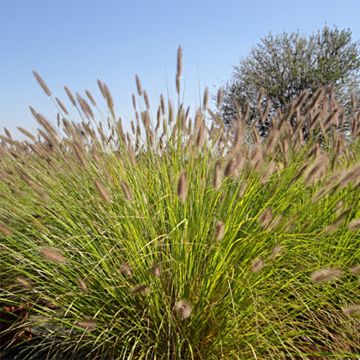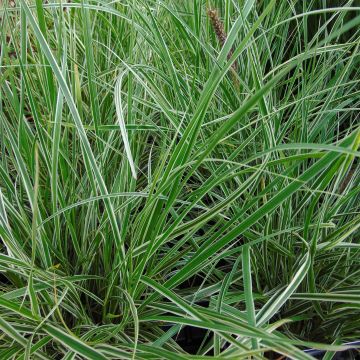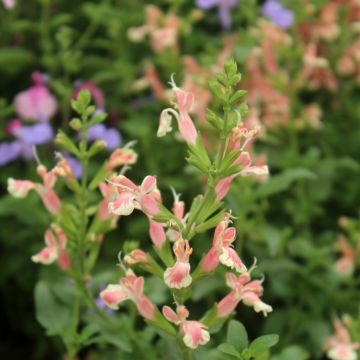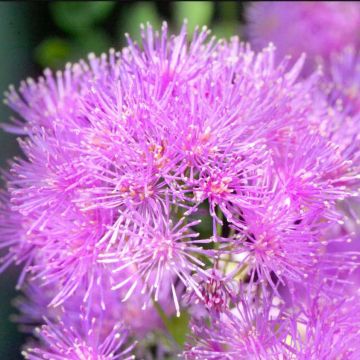Shipping country and language
Your country of residence may be:
Your country of residence is:
For a better user experience on our website, you can select:
Your shipping country:
-
Andorra
-
Austria
-
Belgium
-
Bulgaria
-
Canada
-
Chile
-
Croatia
-
Cyprus
-
Czechia
-
Denmark
-
Estonia
-
Finland
-
France
-
Germany
-
Greece
-
Hungary
-
Iceland
-
Ireland
-
Italy
-
Latvia
-
Lithuania
-
Luxembourg
-
Malta
-
Monaco
-
Netherlands
-
Poland
-
Portugal
-
Romania
-
Slovakia
-
Slovenia
-
Spain
-
Sweden
-
Switzerland
-
United Kingdom
We only deliver seed and bulb products to your country. If you add other products to your basket, they cannot be shipped.
Language:
-
French
-
German
-
Spanish
-
English
-
Italian
My Account
Hello
My wish lists
Log in / Register
Existing customer?
New customer?
Create an account to track your orders, access our customer service and, if you wish, make the most of our upcoming offers.


Pennisetum Windy Simonette - Herbe aux écouvillons
Pennisetum alopecuroides Windy Simonette - Chinese Fountain Grass
Pennisetum x alopecuroides Windy® Simonette
Fountain Grass, Chinese Fountain Grass, Foxtail Fountain Grass, Swamp Foxtail Grass
Order in the next for dispatch today!
Dispatch by letter from €3.90.
Delivery charge from €5.90 Oversize package delivery charge from €6.90.
More information
This item is not available in your country.
Schedule delivery date,
and select date in basket
This plant carries a 12 months recovery warranty
More information
We guarantee the quality of our plants for a full growing cycle, and will replace at our expense any plant that fails to recover under normal climatic and planting conditions.
From €5.90 for pickup delivery and €6.90 for home delivery
Express home delivery from €8.90.
Does this plant fit my garden?
Set up your Plantfit profile →
Description
The Pennisetum Windy 'Simonette' is a new variety of grass with unique foliage, partially coloured purple-red, similar to some Panicum varieties. Probably derived from the Hameln cultivar, this selection offers a compact habit and early flowering that remains decorative for a long time, in the form of large silky and gracefully arched beige caterpillar-shaped flower heads. Perfect for planting in annual and perennial beds, rock gardens, or even a large container on the terrace!
The Pennisetum 'Simonette' is a grass of the Poaceae family with a non-invasive clump-forming habit. It is a hybrid resulting, among others, from Pennisetum alopecuroides, native to a large area of Northeast Asia and Australia. The 'Windy Simonette' grass forms a very dense clump, reaching a height and width of 50-60 cm (20-24in). It has very fine, slightly trailing green leaves with varying degrees of purple-red colouring. The flowering culms emerge from the vegetation in summer, bearing characteristic inflorescences composed of very silky spikelets arranged in feathery plumes 10 to 15 cm (4 to 6in) long. Their colour evolves from green-white to brown-beige in September-October, while the straw-yellow colour of the stems intensifies. The foliage also announces the arrival of autumn with a flourish, turning red in the sunlight. The plant remains decorative throughout part of the winter, covering the remnants of its vegetation with frost. It is perfectly cold-resistant (-15°C (5°F) at least) and thrives in neither wet nor dry soil.
This compact and colourful variety, Windy 'Simonette', will work wonders among late-flowering blue perennials and shrubs such as caryopteris and perovskias. This grass brings a touch of natural grace to any landscape. It can also be paired with more sprawling and lighter plants, such as yarrows, Verbena bonariensis, California poppies, or centaureas.
Pennisetum alopecuroides are a hardy type of grass that can withstand summer droughts quite well. They are ideal for bringing life and movement to flower beds, rock gardens, and walls. These grasses have a unique radiance that shines especially bright in low light and perfectly highlights all perspectives, even in the smallest gardens. If planted in a flower meadow or along a pathway, don't hesitate to touch them as their spikelets are as silky to the touch as they look. Additionally, Pennisetum is an excellent choice for reducing erosion due to its dense root system.
Report an error about the product description
Flowering
Foliage
Plant habit
Botanical data
Pennisetum
x alopecuroides
Windy® Simonette
Poaceae
Fountain Grass, Chinese Fountain Grass, Foxtail Fountain Grass, Swamp Foxtail Grass
Cultivar or hybrid
Other Pennisetum
Planting and care
1. Dig a hole 20 cm (8in) deep and wide in a spot with full sun.
2. Choose light and well-drained soil that is moist to moderately dry, slightly acidic, neutral or limestone to suit this plant's preference.
3. If the soil is heavy, mix some coarse sand, gravel and compost to improve its texture.
4. Partially fill the hole, then remove the plant from its pot and place it so that the top of the root ball is covered with 3 cm (1in) of soil.
5. Firm the soil around the plant and water generously to eliminate air pockets.
6. If the weather is dry, water regularly for a few weeks to help the plant establish properly.
Planting period
Intended location
Care
This item has not been reviewed yet - be the first to leave a review about it.
Summer flowering perennials
Haven't found what you were looking for?
Hardiness is the lowest winter temperature a plant can endure without suffering serious damage or even dying. However, hardiness is affected by location (a sheltered area, such as a patio), protection (winter cover) and soil type (hardiness is improved by well-drained soil).

Photo Sharing Terms & Conditions
In order to encourage gardeners to interact and share their experiences, Promesse de fleurs offers various media enabling content to be uploaded onto its Site - in particular via the ‘Photo sharing’ module.
The User agrees to refrain from:
- Posting any content that is illegal, prejudicial, insulting, racist, inciteful to hatred, revisionist, contrary to public decency, that infringes on privacy or on the privacy rights of third parties, in particular the publicity rights of persons and goods, intellectual property rights, or the right to privacy.
- Submitting content on behalf of a third party;
- Impersonate the identity of a third party and/or publish any personal information about a third party;
In general, the User undertakes to refrain from any unethical behaviour.
All Content (in particular text, comments, files, images, photos, videos, creative works, etc.), which may be subject to property or intellectual property rights, image or other private rights, shall remain the property of the User, subject to the limited rights granted by the terms of the licence granted by Promesse de fleurs as stated below. Users are at liberty to publish or not to publish such Content on the Site, notably via the ‘Photo Sharing’ facility, and accept that this Content shall be made public and freely accessible, notably on the Internet.
Users further acknowledge, undertake to have ,and guarantee that they hold all necessary rights and permissions to publish such material on the Site, in particular with regard to the legislation in force pertaining to any privacy, property, intellectual property, image, or contractual rights, or rights of any other nature. By publishing such Content on the Site, Users acknowledge accepting full liability as publishers of the Content within the meaning of the law, and grant Promesse de fleurs, free of charge, an inclusive, worldwide licence for the said Content for the entire duration of its publication, including all reproduction, representation, up/downloading, displaying, performing, transmission, and storage rights.
Users also grant permission for their name to be linked to the Content and accept that this link may not always be made available.
By engaging in posting material, Users consent to their Content becoming automatically accessible on the Internet, in particular on other sites and/or blogs and/or web pages of the Promesse de fleurs site, including in particular social pages and the Promesse de fleurs catalogue.
Users may secure the removal of entrusted content free of charge by issuing a simple request via our contact form.
The flowering period indicated on our website applies to countries and regions located in USDA zone 8 (France, the United Kingdom, Ireland, the Netherlands, etc.)
It will vary according to where you live:
- In zones 9 to 10 (Italy, Spain, Greece, etc.), flowering will occur about 2 to 4 weeks earlier.
- In zones 6 to 7 (Germany, Poland, Slovenia, and lower mountainous regions), flowering will be delayed by 2 to 3 weeks.
- In zone 5 (Central Europe, Scandinavia), blooming will be delayed by 3 to 5 weeks.
In temperate climates, pruning of spring-flowering shrubs (forsythia, spireas, etc.) should be done just after flowering.
Pruning of summer-flowering shrubs (Indian Lilac, Perovskia, etc.) can be done in winter or spring.
In cold regions as well as with frost-sensitive plants, avoid pruning too early when severe frosts may still occur.
The planting period indicated on our website applies to countries and regions located in USDA zone 8 (France, United Kingdom, Ireland, Netherlands).
It will vary according to where you live:
- In Mediterranean zones (Marseille, Madrid, Milan, etc.), autumn and winter are the best planting periods.
- In continental zones (Strasbourg, Munich, Vienna, etc.), delay planting by 2 to 3 weeks in spring and bring it forward by 2 to 4 weeks in autumn.
- In mountainous regions (the Alps, Pyrenees, Carpathians, etc.), it is best to plant in late spring (May-June) or late summer (August-September).
The harvesting period indicated on our website applies to countries and regions in USDA zone 8 (France, England, Ireland, the Netherlands).
In colder areas (Scandinavia, Poland, Austria...) fruit and vegetable harvests are likely to be delayed by 3-4 weeks.
In warmer areas (Italy, Spain, Greece, etc.), harvesting will probably take place earlier, depending on weather conditions.
The sowing periods indicated on our website apply to countries and regions within USDA Zone 8 (France, UK, Ireland, Netherlands).
In colder areas (Scandinavia, Poland, Austria...), delay any outdoor sowing by 3-4 weeks, or sow under glass.
In warmer climes (Italy, Spain, Greece, etc.), bring outdoor sowing forward by a few weeks.





















